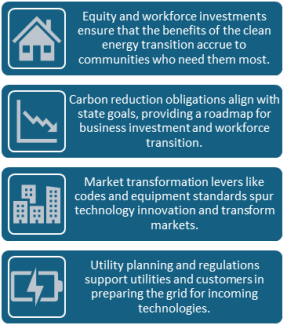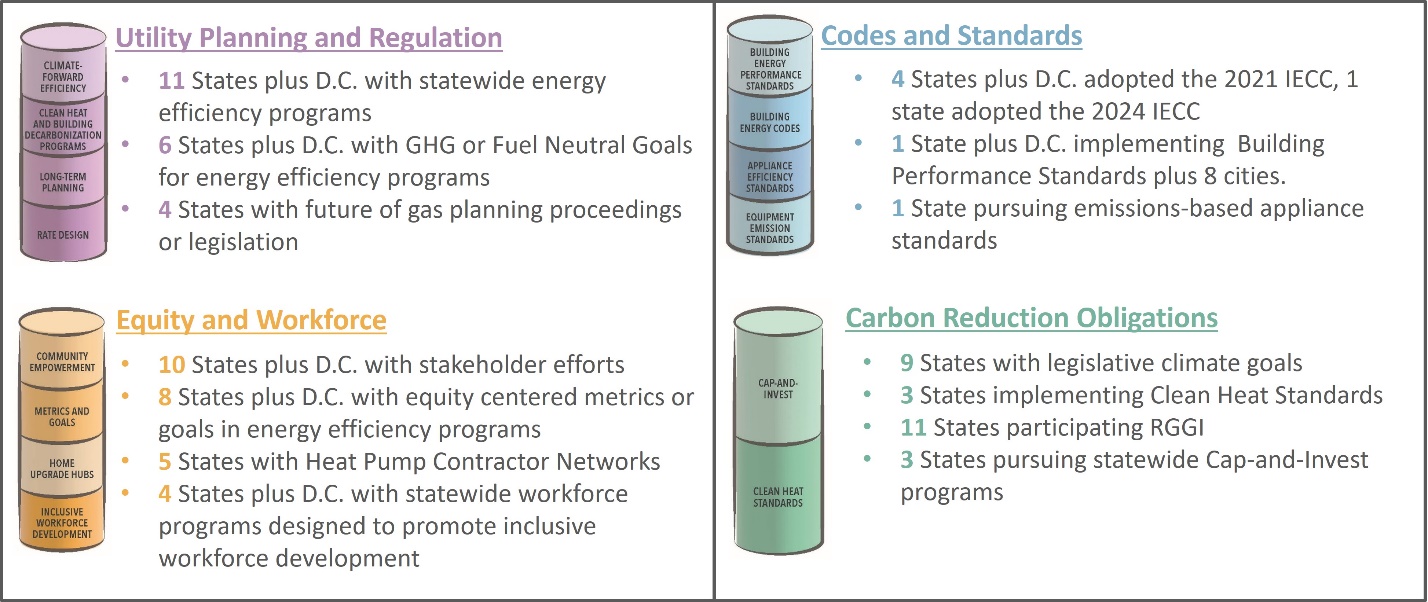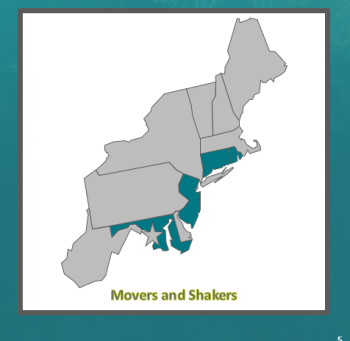

By Erin Cosgrove | Fri, March 28, 25
NEEP’s newest resource – the 2024 Regional Roundup – provides a snapshot of state-level energy efficiency policy for all 13 jurisdictions in the NEEP region. Building on previous editions of this resource, the latest version uses NEEP’s building decarbonization table as a lens through which to measure state progress. The four ”legs” of the table – utility planning, building codes and equipment standards, carbon reduction obligations, and equity and workforce initiatives - add context and new data to help industry stakeholders better understand the initiatives underway in the Northeast. We also include a table for each state, ‘efficiency by the numbers,’, which provides data on savings as a percentage of sales, spending on low-income programs, and current portfolio targets. This results in data points across 28 policy categories.
Across the NEEP region, the 2024 Regional Roundup provides information and insights on the current energy efficiency and building decarbonization landscape in states. This blog shares an overview of some regional takeaways, recognition of states that are leading the way in setting their table for building decarbonization; and highlights the movers and shakers, or those who are making the biggest changes in our region.
Reflections on the Region
Here are some high-level takeaways to provide an overview of key changes and trends we are seeing throughout the region:
- No two states are the same. No single policy has been enacted by all states, and no two states have the same set of policies. Yet states are implementing policies across their building decarbonization table, showing that there is alignment in adopting strategies within each of the four legs of the table - utility planning, building codes and equipment standards, carbon reduction obligations, and equity and workforce initiatives.
- Some policies are adopted at higher rates than others. The most commonly adopted policies include:
- Statewide energy efficiency programs, which treat energy efficiency as a resource for utilities and are funded through utility customers. These implemented in every jurisdiction in the NEEP region aside from West Virginia;
- Participation in the Regional Greenhouse Gas Initiative. Eleven territories are part of this regional cap-and-invest program; and
- Equity-focused stakeholder efforts or working groups, which appear in 10 territories.
- New policies have emerged. The 2024 Regional Roundup features a lot of new policies, including clean heat standards and zero emission appliance standards. Maryland is the only state looking at both. In a novel approach, the state is implementing them together, under the umbrella of Clean Heat Rules.
- Equity Initiatives are continuing to grow. In addition to 10 jurisdictions with equity-focused working groups, nine have implemented equity-focused metrics for their energy efficiency programs. Massachusetts and Rhode Island stand out in this category. Rhode Island is introducing equity tracking metrics for its energy efficiency plans for the first time; and Massachusetts includes equity performance incentive mechanisms (PIMs), which has been updated in the Mass Save 2025 – 2027 Plan to include a component for renters.
States Setting the Table for Building Decarbonization
This section looks at how states are “setting the table for building decarbonization” by enacting the most policies of those identified in the Roundup. The NEEP region has a number of states that are top tier in advancing energy efficiency, with five states landing in the top 10 of the ACEEE State Energy Efficiency Scorecard (Maryland, Massachusetts, New York, New Jersey, and Vermont). As the Regional Roundup takes a more expansive view of building decarbonization policies, the states that stand out are those who are enacting policies that tackle the four legs – utility planning, building codes and equipment standards, carbon reduction obligations, and equity and workforce initiatives. The states achieving this are: Massachusetts with 23 policies; Maryland and New York with 21 policies each; Vermont with 20 policies, and Connecticut and Maine with 18 policies each.
These states show that there are many ways to set the table for building decarbonization. As highlighted above, even within this group (and between states that have tied scores) no two states are the same. For example, Connecticut and Maine are tied, yet they differ in how they implement their energy efficiency programs, and the goals and mandates embedded in them. Connecticut implements through their utilities and Maine implements through Efficiency Maine Trust, an independent, quasi-state agency. Further, although Maryland and New York are tied, New York has been building upon longstanding policies, like the New Efficiency New York report published in 2018, while Maryland had a big year for building decarbonization 2024 that included shifting their energy efficiency programs and introducing building performance standards, clean heat standards, and zero emission appliance standards at the state level.
While states differ in implementation, they all have statewide benchmarks and strong commitments to equity that help in propelling and designing their policies. Massachusetts, Maine, and New York have adopted heat pump targets through legislation or an executive order, showing how important this technology is for our region to achieve building decarbonization. Connecticut has benchmarks as well, with weatherization goals set through legislation. Additionally, these states have found ways to integrate equity into both existing and new policies. In Vermont, the clean heat standard includes an equity-focused advisory group to oversee implementation and a set aside for low- and moderate-income Vermonters. In Massachusetts and New York, efficiency programs are doing more to center the needs of customers and communities, providing measures as well as technical assistance at no cost.
Regional Movers and Shakers
The regional movers and shakers - those states that have made the biggest changes since the 2022 Regional Roundup, include Connecticut, Maryland, New Jersey, and Rhode Island.
One common theme among these states is strong leadership from state energy and environmental offices. A number of these states have implemented advanced policies largely due to state energy offices recognizing a pathway to enact change and implementing that pathway. In Rhode Island, for example, the state energy office implements a statewide electrification program, the Clean Heat RI program, that enables fuel switching, which is not allowed under the energy efficiency programs. State energy offices in both Connecticut and New Jersey implemented strategies to pursue electrification and building decarbonization in energy efficiency plans that shifted program offerings. Connecticut adopted a state specific benefit cost test and mandated that utilities explore the removal of natural gas incentives. New Jersey’s new energy efficiency programs include building decarbonization programs and a statewide demand response plan that were both initiated through staff recommendations. Lastly, Maryland’s enactment of clean heat standards and zero emission appliance standards was first announced in a state climate plan and solidified through an executive order.
What to Look For in the 2025 Roundup
While we have concluded 2024, the Roundup is not done. The policy landscape in our region continues to be active, with states looking to improve and implement policies across the region. We will provide updates on these policy areas in 2025:
- Trends on BPS. So far only one state in our region has adopted building performance standards, but nine cities have (Washington, D.C.; Boston, MA; Cambridge. MA; Newton, MA; Philadelphia, PA; Montgomery County, MD; and New York City NY). These city-level efforts can lead to change on the state level. We look forward to reporting on movement at both the state and city level in future iterations.
- Adoption of cap-and-invest and/or clean heat standards. States are recognizing the need to identify additional funding outside of ratepayer tax dollars. Clean heat standards and cap-and-invest programs are both carbon reduction obligations which require obligated parties—fuel suppliers, electric and gas utilities, and other carbon-emitting sectors or industrial facilities—to reduce GHG emissions or provide clean heat services. They can also encourage obligated parties to change their business models and create sustained, long-term incentives that unlock resources for the clean energy transition. Cap-and-invest has been successful (and popular) in California and Washington, and we look forward to supporting our region.
- Investing in contractor networks and training. One final area to watch is how states invest in their workforce. Ensuring quality installations and service will be key to decarbonizing our buildings. About half the states in the NEEP region maintain an existing contractor network with trainings and certifications alongside their energy efficiency programs. Some states have adopted a contractor search tool, which enables customers to find local certified contractors. We hope to see the trend continue toward further investment in heat pump and weatherization contractor training, support, and marketing. These policies enable the workforce to grow and connect with customers across our region.
Conclusion
We hope this resource provides information and insights for all stakeholders in this space, to gain knowledge of what is happening across the NEEP region. With the increased uncertainty for clean energy at the federal level, leadership and action at the state and community level is now more impactful than ever. As shown in the 2024 Regional Roundup, the region continues to lead the way in leveraging energy efficiency to lower energy bills, reach climate goals, and build a strong economy. NEEP looks forward to assisting states in our region continue to lead.




